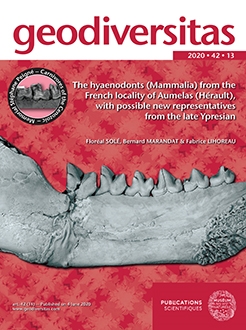Floréal Solé, Bernard Marandat, Fabrice Lihoreau
Geodiversitas 42 (13), 185-214, (4 June 2020) https://doi.org/10.5252/geodiversitas2020v42a13
KEYWORDS: Europe, carnivores, Paleogene, Endemism, Tethys, new species
We describe the carnivorous mammals from the Eocene French locality of Aumelas (Hérault, France). All the carnivores that have been recovered from the fossiliferous locality belong to the Hyaenodonta, a group that was very diverse during the Eocene of Europe. Three new species are described. Matthodon peignei n. sp. is intermediate in size between M. menui (Rich, 1971) and M. tritensLange-Badré & Haubold, 1990. This is the first known occurrence of this genus in southwestern Europe. Oxyaenoides aumelasiensis n. sp. is distinct from other OxyaenoidesMatthes, 1967 species by its smaller size (15% smaller than O. bicuspidensMatthes, 1967). A third new species is proposed from Aumelas: Leonhardtina meridianum n. sp. The hyaenodonts from Aumelas appear to be morphologically similar to hyaenodonts from late Ypresian to early Lutetian of the northwestern Europe (European mammal reference level MP10 and MP11). These new species are incorporated into a phylogenetic analysis and are resolved within the clade Hyaenodontoidea. Our analysis interestingly recovered the Prionogalidae and Thereutherium as members of the Hyainailourinae. Based on the carnivorous faunal analysis, Aumelas is likely close to the Ypresian/Lutetian transition. However, because the hyaenodonts display unusual sizes that could result from provincialism, dates for Aumelas based on only these taxa should be treated cautiously, and will require confirmation based on a broader faunal analysis.

